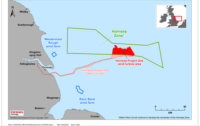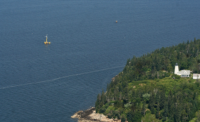Maine is set to double its current onshore wind capacity with state regulators' approval of the 1-GW King Pine project in its northern region along with a 345-kV transmission line to deliver the electricity to ratepayers in the state and in Massachusetts.
The estimated $2-billion development would be New England’s largest onshore wind project. A state filing says the project is set to have up to 179 turbines, each about 5.6 MW, considered industry leading for onshore wind.
The developer, Boston-based Longroad Energy, has not chosen contractors for the project, reportedly set to begin construction in stages in 2026 and be on line by late 2028. It now is negotiating long-term off-take agreements with investor-owned utilities in both states and to seek federal clean energy funding, as directed by the state utilities commission.
The $2.78-billion transmission line, developed by New York City-based LS Power Base and wilh estimated capacity of 1.2 GW, will distribute energy generated by the project to the New England grid. The Massachusetts Dept. of Energy Resources has agreed to contract for up to 40% of the power, and cover the same proportion of transmission line cost.
“This is an important moment in the effort to invest in northern Maine and provide the area with electric infrastructure it has long lacked,” said Matt Kearns, Longroad chief development officer.
The approval comes amid concern over rising wind energy project costs and ratepayer impacts, but the two projects could save $1 billion over 20 years, according to the commission. Chairman Phil Bartlett said the cost is “in the range that [Maine] policymakers should reasonably have expected” in enacting a 2019 law that raises its renewable energy goal to 80% by 2030.
Maine’s offshore wind program also is advancing, with the U.S. Interior Dept. last month approving a 9,700-acre floating turbine research site in a deep-water federal tract in the Gulf of Maine, about 30 miles from land. The action enables a federal environmental review of Maine’s application for an array of 10 floating wind turbines of about 15 MW each. called New England Aqua Ventus. They will use the University of Maine’s patented VolturnUS concrete hull technology, with deployment in 2026 and commercial development several years later.
A 1/8 scale version of the turbine successfully generated power to the grid several years ago.
The project is a partnership of the university and state, with funding also from private developers Diamond Offshore Wind and RWE Renewables.
The approval “opens the door … to continue development of the first floating turbine research array in the U.S., bringing floating wind closer to reality,” says Habib Dagher, founding director of the university’s Advanced Structures and Composites Center. "It will help evaluate environmental and fishing impacts, while scaling up the production of the concrete hull technology, and training the workforce needed to start a new industry."





Post a comment to this article
Report Abusive Comment